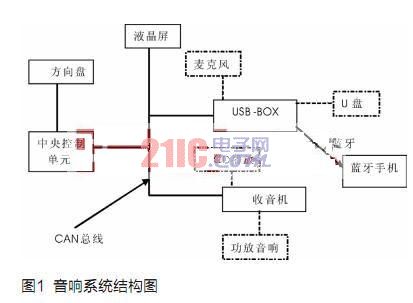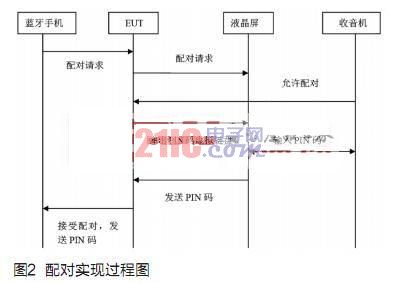introduction
This article refers to the address: http://
In automotive electronic systems, CAN bus communication technology not only reduces the weight of the wire harness, but also improves the efficiency of the car. More importantly, it realizes the information sharing and data transmission of the automotive electronic network, which can be used to divide an application according to its function. Demolition is implemented in different components, which is very flexible in implementing each functional subsystem. The components in the system are used more widely and fully, and individual components can be applied in multiple functional systems. It can be said that the emergence of CAN bus better reflects the characteristics of network reuse. After the successful application of Bluetooth technology in the field of consumer electronics to the field of automotive electronics, its development and testing encountered certain challenges. The author combined a car infotainment device based on CAN bus and Bluetooth technology developed by a vehicle manufacturer. Introduce key technologies in the development and testing of automotive electronic products based on CAN bus and Bluetooth technology.
product development
The product is an integrated electronic audio control unit (USB-BOX) which integrates USB audio playback, Bluetooth hands-free, Bluetooth audio streaming and other functions. It is combined with the car audio system through CAN bus to realize playback. Ordinary U disk music files (MP3, WAV, WMA, etc.), at the same time can realize hands-free listening, making calls and playing streaming music through the Bluetooth function [1]. The sound system includes LCD screen, radio, steering wheel and USB-BOX. The LCD screen is used to realize song file information, phone related information and phone book display. The radio realizes CD music playback and control functions, and the radio and steering wheel There is a button control interface to realize the music control and hands-free operation of the USB-BOX. The system structure is shown in Figure 1.

In this CAN network car audio system, the radio and steering wheel CAN node provides a human-machine interface to control the USB-BOX, while the USB music player and the Bluetooth hands-free function related LCD display page are controlled by the USB-BOX. The USB-BOX program design uses a software architecture based on a finite state automaton to decompose the entire control flow into several concurrent sub-state machines according to functions. Each state machine is implemented as a task, which is implemented in the sub-state machine. The process node is used as a sub-state, and the process advancement is used as a jump of the state machine, which makes the whole system architecture clear, simplifies the implementation, and facilitates system debugging and subsequent function expansion [2].
In the implementation of the state machine, the key jump conditions are CAN frame and Bluetooth signal. The CAN frame is mainly the management of the identifier. The identifier refers to what kind of page should be displayed on the current LCD screen, what kind of display information and navigation are provided. Select, which control commands corresponding to the radio and steering wheel button operations on this page, which selective operations (select, exit, navigate up and down, forward and backward navigation) [3], shared by USB-BOX and radio management. The Bluetooth signal involves different differences in the same function of different mobile phones, the information combination is incomplete, and the order is not fixed, which will bring certain compatibility problems [5]. The following is an example of electrical management to describe the design of the state machine.
Firstly, according to the whole call management process, Ready, IncomingCallEstablish and ActiveCall are designed. The default start state of USB-BOX is Ready. When the mobile phone calls, the mobile phone sets the Bluetooth signal CALL_SETUP_IND (call process prompt) and RING_IND (call ring alert). The call information such as CALLER_ID_IND (caller number) is transmitted to the USB-BOX, and the USB-BOX enters the IncomingCallEstablish state, and the ringing prompt information is sent to the radio of the management amplifier audio through the CAN frame, and the caller number is sent to the LCD screen, and the radio plays. The ringtone, at the same time, pops up the display page on the LCD screen, including the phone number, and provides two navigation options for answering. The identifier of this page is the call management identifier. At this time, you can use the navigation button on the radio to select whether to answer. When you press the SELECT button on the navigation to answer button, the radio will send the answering call command to the USB-BOX. The USB-BOX sends the answering command to the mobile phone via the Bluetooth signal. The mobile phone answers the incoming call. After the call is established, the mobile phone sends the Bluetooth signal CALL_IND=1 (call setup) to the USB-BOX, and the USB-BOX enters the ActiveCall state. In this state, when the selection button is pressed on the radio, the USB-BOX receives To the button operation command, send a CAN frame to the LCD screen, pop up a navigation page, including hanging up, hold options, select to hang up, the radio sends the hang up command to the USB-BOX through the CAN frame, and the USB-BOX passes the Bluetooth signal. Send the phone to the phone to hang up, after hanging up, the phone sends the Bluetooth signal CALL_IND=0 (end of call) to the USB-BOX, the USB-BOX enters the Ready state, and the call ends are sent to the LCD screen and the radio through the CAN frame.
product testing
The following is a test of the Bluetooth characteristics of the product to illustrate how to use the CAN bus and Bluetooth technology to complete the Bluetooth test of the product. The products to be tested are represented by EUT.
Because it is impossible to build all the external environments required for the product to run directly to test the functions of the product, the test tool is designed to test the product on the production line, and because the EUT implements more functions, the time required to complete a single EUT test is compared. Long, in order to meet the fast pace of production tempo, multiple tooling is required to test multiple EUTs on the production line. The Bluetooth feature of the EUT refers to whether it is stable on the Bluetooth radio communication, whether the software is running normally, and does not involve specific function items. We determine the RF communication by determining the signal strength of the EUT, and judge it by a specific function item-pairing. Whether the software is working properly.
The following describes the test environment and test methods first, and then details the implementation of the test method.
Since the EUT is a Class 2 Bluetooth device with a valid range of 10m, and the production line itself is about 10 meters, there are multiple test fixtures and multiple EUTs in the range of 10m, so in order to ensure that the test fixture is actually testing the EUT on its test bench, The Bluetooth address of this particular EUT on the tooling test bench needs to be determined for subsequent pairing to complete the test. Since the EUT distance between the test tool and its test bench is fixed, and the distance between the tool and the EUT on the test bench is the closest between a test tool and multiple EUTs, the search device can be measured on the test tool. The signal strength search function [4] searches for the EUT in the valid range. As long as the signal strength of the EUT on the test bench is OK, the Bluetooth address with the strongest signal strength is the EUT on the tooling test bench. Bluetooth address.
The implementation of the EUT pairing process (Fig. 2) is a typical function realized by the CAN bus and Bluetooth technology. First, the EUT sends the pairing request from the Bluetooth mobile phone to the LCD screen through the CAN bus, and then uses the buttons on the radio. Allow pairing, send to the EUT through the CAN bus, the EUT then sends the pop-up PIN code virtual keyboard request to the LCD screen, then enter the PIN code through the button on the radio on the virtual keyboard on the LCD screen, and then the PIN code through the CAN bus. Sended to the EUT, the EUT accepts the Bluetooth phone pairing and sends the PIN code to complete the pairing.

Here, a unified PIN code is agreed, and only the Bluetooth pairing on the test tool, the pairing request sent by the EUT through the CAN bus, the function of sending the allowable pairing command through the CAN bus, and the function of sending the PIN code to the EUT can complete the pairing of the EUT. Functional testing. If the EUT Bluetooth feature on the test bench is OK, the pairing operation can be successfully completed. If the signal strength of the EUT does not meet the requirements, and the Bluetooth address obtained by searching for the strongest signal strength is another EUT, the test tool is combined with another one. The EUT on the tooling test bench does not have a CAN bus connection, so it cannot receive the pairing request. Setting a timeout here can lead to the conclusion that the EUT test is not OK.
Conclusion
The author developed a car electronic product based on CAN bus and Bluetooth technology. The product is stable and reliable. It has been successfully loaded and applied. This paper analyzes the principle and characteristics of its product development and testing, and introduces the development with specific examples. The implementation of the test.
Tobacco control has been a common global concern, while the traditional tobacco industry gradually, new tobacco has become the new strategic layout of tobacco giants. In this context, the emergence of e-cigarettes has further led to the replacement of traditional tobacco. At present, there are already a thousand different types of e-cigarettes, which have undergone several stages of development. The e-cigarette we are introducing today is the CBD pod systewm, a new type of e-cigarette. In this article we will combine the characteristics of the CBD with a brief analysis of it.
·Anti-anxiety
According to scientific studies,CBD can help depressed patients reduce their anxiety. The use of CBD can help maintain endogenous cannabinoids at a reasonable level, making the patient feel good and happy physically, and without any dependence.
·Anti-ageing
CBD is very powerful in anti-ageing. As a non-psychoactive component of the cannabis plant CBD inhibits the glutamate toxic response of cortical neurons and suppresses excessive oxidative stress, helping the body to achieve anti-ageing effects.
·Anti-inflammatory
CBD reduces the free radicals that cause neurodegenerative diseases and reduces swelling through its anti-inflammatory effects. In addition, CBD stimulates appetite and relieves pain.
China Disposble Vape Pen,E-Cigarette Cbd Vaporizer,Best Disposable Cbd Vape Pen,Disposable Cbd Vape
Shenzhen MASON VAP Technology Co., Ltd. , https://www.masonvap.com